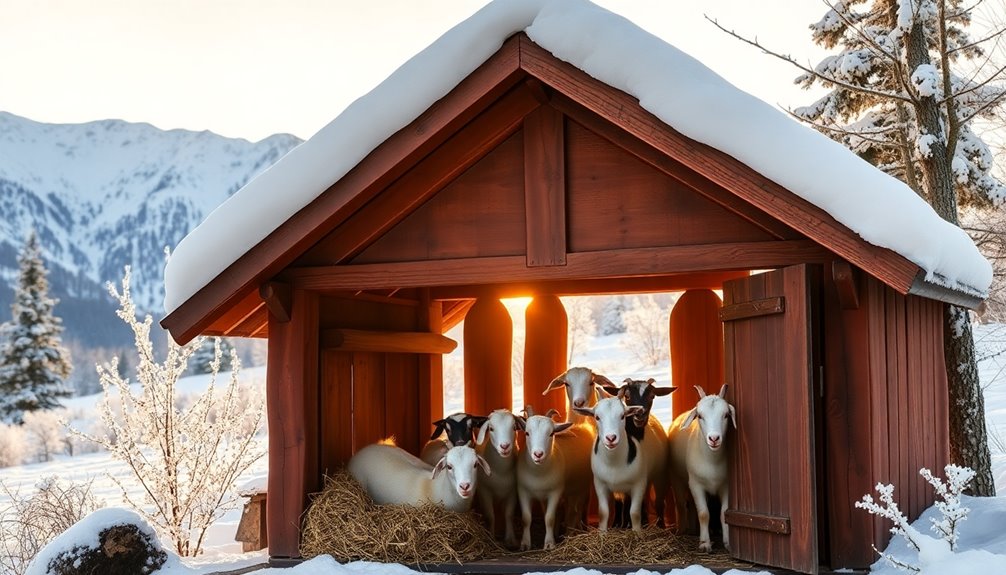During fall, toxic leaves from trees like oak, black walnut, red maple, and rhododendron can pose serious dangers to grazing animals. Some leaves contain toxins, tannins, or compounds that cause illness or even death if ingested. Fallen leaves and husks may also carry mold or pollutants. Recognizing these hazards is essential for protection. To learn how to identify and manage these risks effectively, keep exploring the key hazards associated with fall foliage.
Key Takeaways
- Decaying leaves from trees like oak, maple, and cherry can contain toxins harmful to grazing animals.
- Black walnut leaves and husks release juglone toxin, risking toxicity and nutrient deficiencies in livestock.
- Coniferous trees such as yew, junipers, and firs contain toxic compounds that can cause severe poisoning if ingested.
- Poisonous plants like mountain laurel, rhododendron, and poison ivy pose health risks through ingestion or skin contact.
- Proper leaf removal and plant identification are essential to prevent grazing animals from consuming toxic fall foliage.
Oak Leaves and Acorns

While oak leaves and acorns add vibrant color to fall scenery, they can also pose hazards if you’re not careful. As these leaves fall and decay, they can contribute to nutrient deficiency in your soil, especially if they cover your grass excessively. Decaying oak leaves form a thick layer that hampers sunlight and air circulation, slowing down grass growth and promoting mold. If animals graze near fallen leaves, they might ingest acorns containing tannins, which can be toxic in large amounts. Additionally, the decay process releases substances that could irritate or harm grazing animals. Proper leaf management can help in reducing these risks and maintaining a healthy pasture. Monitoring projector contrast ratios can help in understanding how visual clarity is affected under different conditions. Staying vigilant about leaf accumulation and promptly removing decayed material helps prevent nutrient imbalance and reduces the risk of hazards associated with leaf decay and acorn ingestion. Regular debris removal also minimizes the chances of mold development and other health issues in grazing areas, especially considering the importance of air filtration in maintaining healthy environments for animals. Furthermore, incorporating mulching techniques can accelerate leaf decomposition and improve soil health while reducing hazards.
Black Walnut Leaves and Husks
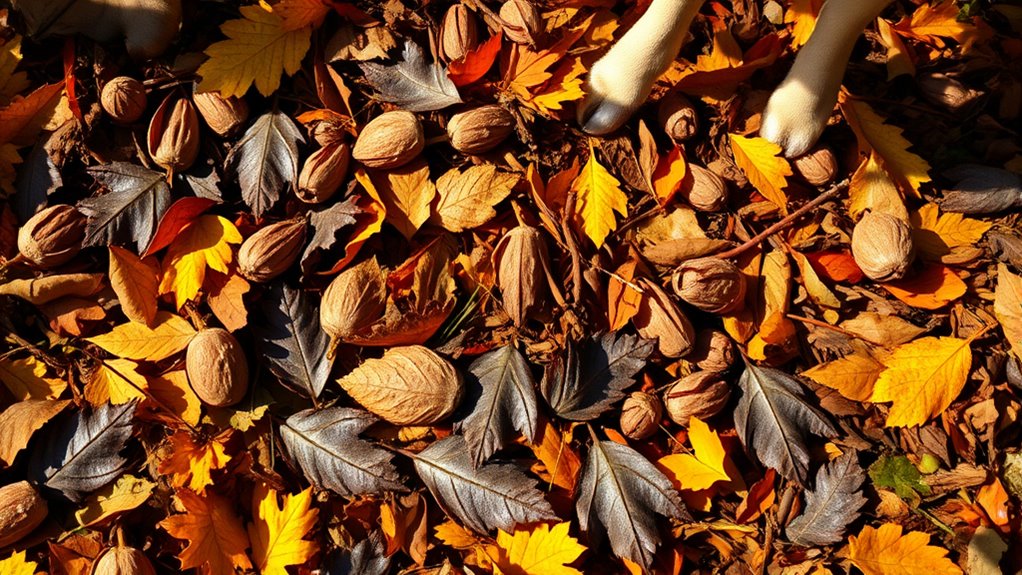
Black walnut leaves and husks can pose significant hazards to your garden and health. The juglone toxin they contain affects plant identification, making it tricky to distinguish harmful plants. If animals graze near fallen husks, they risk nutrient deficiencies and toxicosis. Be alert for these issues:
- Juglone inhibits root growth in sensitive plants
- Toxins can cause digestive upset in grazing animals
- Fallen leaves decompose slowly, spreading toxins
- Nutrient deficiencies may develop in nearby plants
- Recognizing toxic plants is essential for maintaining garden safety
Proper plant identification helps you recognize susceptible species. Remove fallen leaves and husks promptly to prevent toxin buildup. Avoid planting sensitive plants near black walnuts. Monitoring your garden and grazing areas reduces hazards, keeping your plants healthy and your animals safe. Additionally, understanding toxic plant identification can help prevent accidental exposure and improve your garden management practices. Being aware of toxic plant effects enables better decision-making to protect your livestock and landscape. Recognizing the importance of home decor in organizing and beautifying your space can also contribute to a safer environment for both your plants and animals.
Red Maple and Silver Maple Leaves
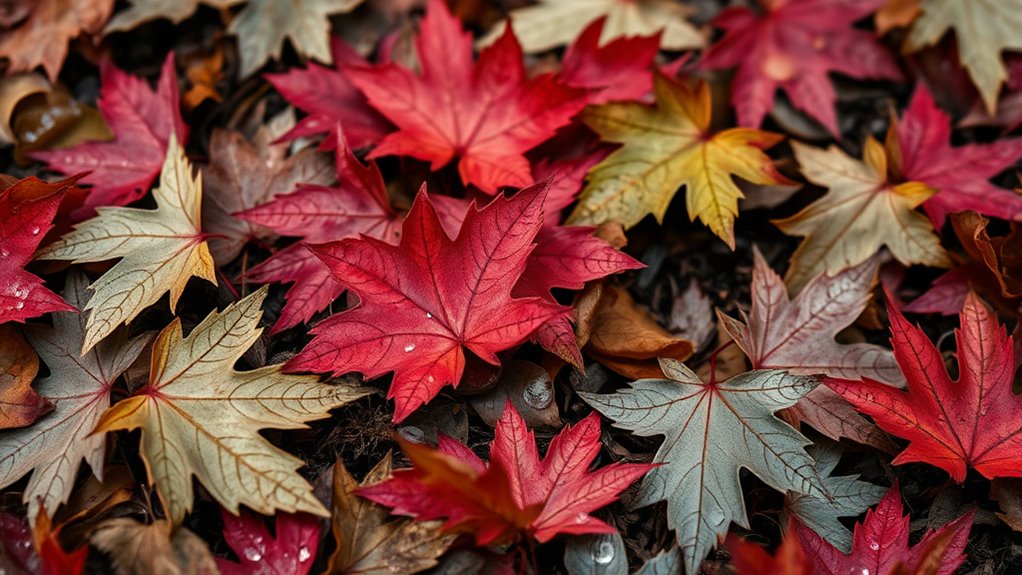
Red Maple leaves contain toxins that can be harmful if ingested by pets or children, so you should be cautious when they fall. Silver Maple leaves also pose risks, especially since they tend to cluster and create slippery surfaces. Being aware of these hazards helps you stay prepared during the fall season. Additionally, protective styling benefits from certain plant debris can help prevent direct contact with harmful leaves.
Red Maple Toxins in Leaves
During the fall, red and silver maple leaves can pose serious health risks because they contain toxins that are harmful to humans and animals. The primary concern is the presence of red maple leaf toxin, which can cause hemolytic anemia in livestock if ingested. To manage these risks effectively, you need to focus on leaf toxin identification and seasonal foliage management. Recognizing vetting for safety in red maple leaves during autumn is essential for preventing poisoning. You should:
- Recognize toxic red maple leaves during autumn
- Remove fallen leaves from grazing areas promptly
- Avoid allowing animals to browse under trees with red or silver maple foliage
- Implement barriers or fencing during peak leaf fall
Silver Maple Leaf Risks
While red maple leaves are well-known for their toxic risks, silver maple leaves also pose similar dangers during fall. When grazing animals consume silver maple leaves, they risk developing symptoms like weakness, vomiting, and even organ damage. To reduce these hazards, implement safety precautions such as monitoring pasture intake and removing fallen leaves from grazing areas. Proper pasture management is essential to prevent animals from accessing toxic foliage, especially during peak leaf fall. Consider fencing off high-risk zones or rotating grazing to limit exposure. Regularly inspect your pasture for leaf accumulation and promptly clear areas where animals feed. Staying vigilant about silver maple leaf risks helps protect your livestock and ensures safe grazing during the colorful fall season. Additionally, understanding the self-watering plant pots system can assist in maintaining healthy plants in your landscape, which can be part of a comprehensive property management plan.
Mulberry Leaves
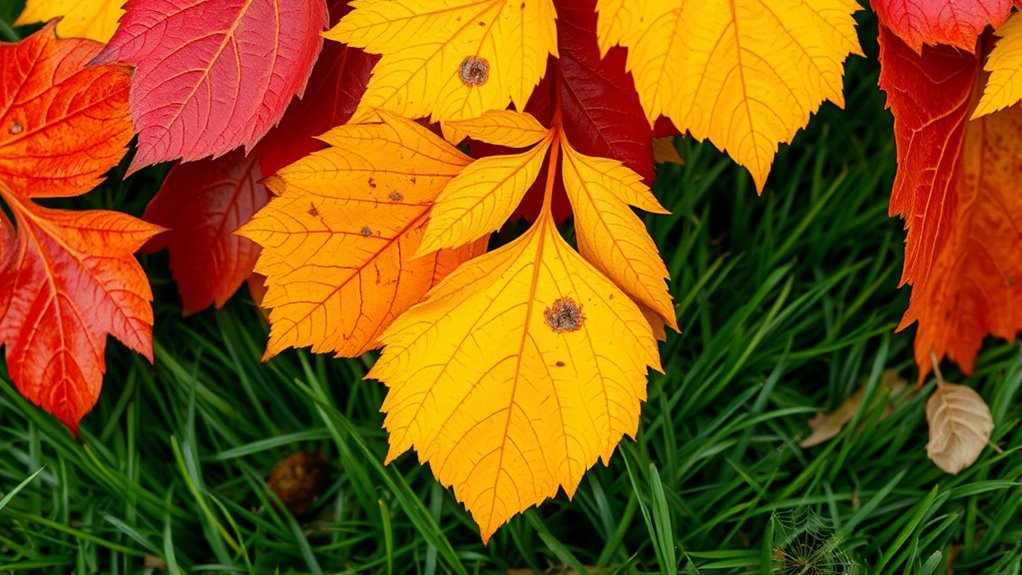
Mulberry leaves, a common sight in fall foliage displays, can pose certain hazards if you’re not careful. These leaves have a high nutritive value, making them appealing to grazing animals, but their leaf structure can sometimes cause issues. These broad, tender leaves are rich in nutrients like proteins and vitamins, which attract animals seeking forage. However, overconsumption can lead to digestive problems or toxicity. Be mindful of the following:
- The leaf structure varies between species, affecting digestibility.
- Excessive intake may cause gastrointestinal distress.
- Certain mulberry varieties contain compounds that can be toxic in large amounts.
- Always monitor animals when they graze near fallen leaves, especially during peak fall.
- Additionally, pollutants from air pollution and environmental degradation may contaminate leaves, posing further health risks to grazing animals. Recognizing the importance of heat pump technology can also be beneficial in reducing environmental impact and promoting sustainable farming practices.
- Proper forage management techniques can help prevent overgrazing and reduce health risks associated with mulberry leaves. This includes testing leaves for contaminants and ensuring they are harvested from clean areas to minimize exposure to pollutants. Implementing regular maintenance of grazing areas can help identify and mitigate potential hazards early.
Cherry and Peach Tree Leaves
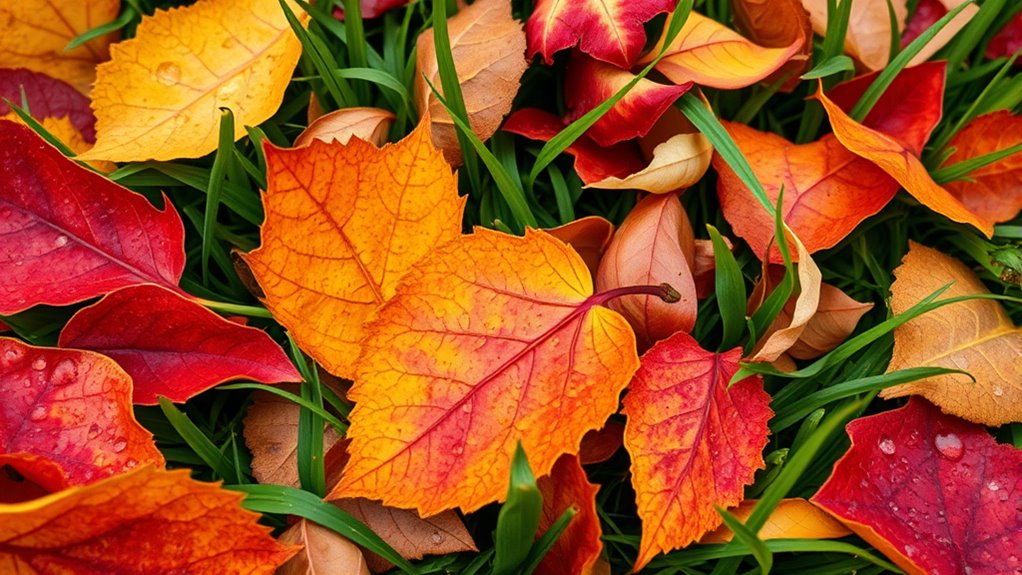
Cherry and peach tree leaves can pose health risks if ingested in large quantities, especially for livestock and pets. These leaves contain compounds that may cause toxic reactions, leading to symptoms like vomiting, diarrhea, or weakness. During fall, leaf discoloration signals potential toxicity, and garden pests can damage leaves, increasing the risk of ingestion. Be cautious when grazing animals near these trees, especially if leaves show signs of decay or pest infestation. Additionally, AI integration in mobile devices is advancing rapidly, influencing how we monitor and respond to environmental hazards like toxic leaves. Monitoring environmental conditions can help identify high-risk periods when leaf toxicity may be more prevalent. Recognizing the signs of toxic leaf ingestion early can aid in prompt treatment and prevention of severe health issues. Moreover, understanding the weight of wind turbine blades can inform environmental assessments related to land use and safety.
Recent studies highlight that toxic compounds in leaves can vary depending on environmental factors, which should be considered when managing grazing areas.
Yew and Other Coniferous Foliage
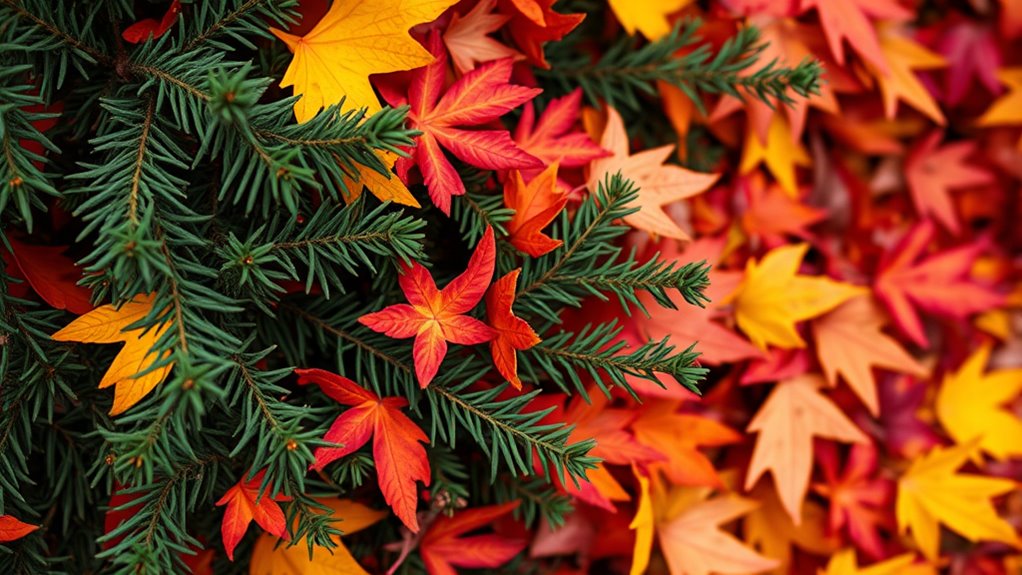
Yew and other coniferous foliage can pose serious health risks if ingested, especially for livestock, pets, and humans. Yew toxicity is well-documented, and consuming even small amounts can cause severe symptoms or death. Recognizing conifer risks helps prevent accidental poisoning. Be cautious during fall when these plants shed needles and branches. Key points include:
- Yew contains toxic alkaloids that affect the heart and nervous system.
- Conifers like junipers and firs also carry potential toxins, though less potent.
- Ingesting yew foliage can lead to sudden death in animals.
- Keep these plants away from grazing areas and pet access points.
- Educating yourself about toxic plant identification is crucial for preventing accidental ingestion and ensuring the safety of your animals and family.
Understanding the dangers helps you protect your animals and loved ones from yew toxicity and conifer risks.
Mountain Laurel and Rhododendron Leaves
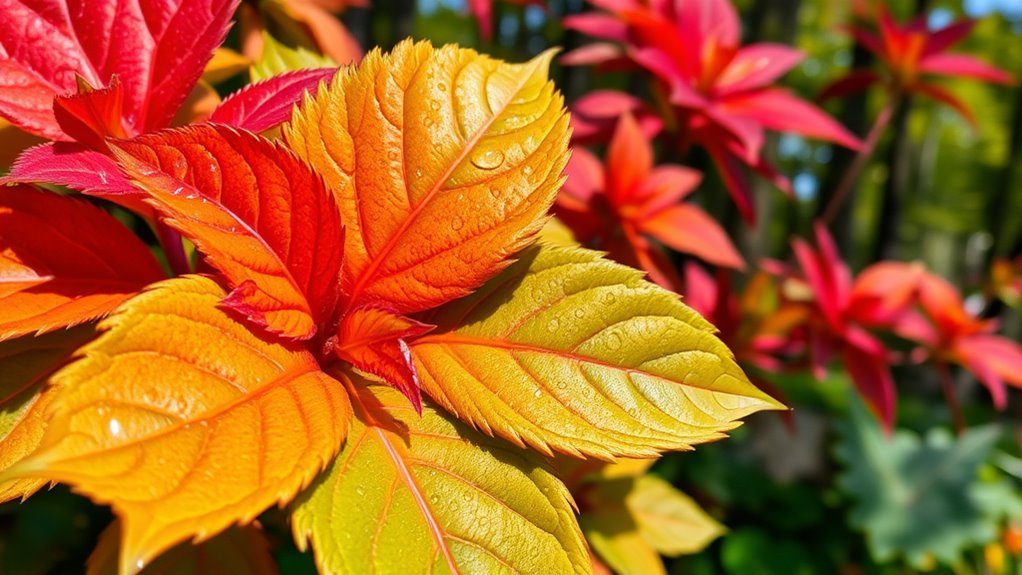
While coniferous foliage like yew can pose serious health risks, some deciduous plants also demand caution during fall. Mountain laurel and rhododendron leaves contain toxins that can harm grazing animals if ingested. These plants produce grayanotoxins, which interfere with nerve signals and heart function.
| Plant Type | Toxic Components |
|---|---|
| Mountain Laurel | Grayanotoxins |
| Rhododendron Leaves | Grayanotoxins |
Be mindful of these plants in your pasture, especially during fall when leaves fall and become accessible. Eating even small amounts can cause vomiting, weakness, or more severe symptoms in animals. Proper identification and removal are essential to prevent accidental poisoning.
Poison Ivy, Poison Oak, and Poison Sumac
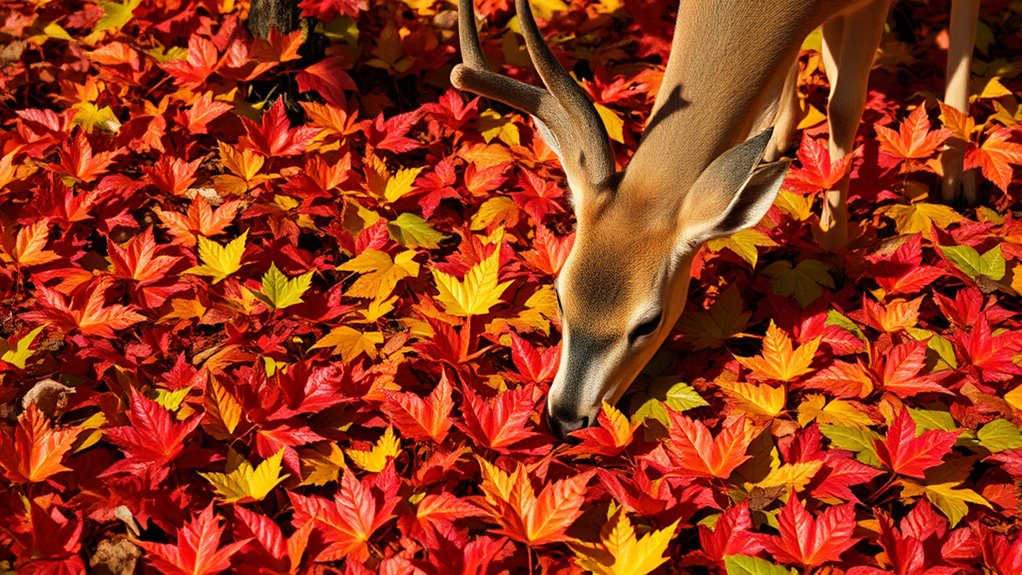
You need to learn how to identify poison ivy, oak, and sumac to avoid skin irritation. Recognizing these plants helps prevent accidental contact with humans and animals. Taking simple precautions can keep both you and your pets safe during fall adventures.
Identifying Toxic Plants
Toxic plants like poison ivy, poison oak, and poison sumac can cause severe skin irritation if you come into contact with them. To stay safe, learn to identify these plants during seasonal color change, when their leaves often turn shades of red, orange, or yellow. Recognizing these plants can prevent accidental exposure, especially as wildlife migration brings animals into contact with them.
Key features include:
- Poison ivy has three leaflets with a shiny, smooth surface.
- Poison oak resembles oak leaves, often lobed and hairy.
- Poison sumac grows as a shrub or small tree with smooth, grayish berries.
- All three thrive in wooded areas and along trails, blending into fall foliage.
Being able to identify these plants helps protect both you and grazing animals from dangerous exposure.
Preventing Animal Exposure
To prevent animals from coming into contact with poison ivy, poison oak, and poison sumac, it’s essential to keep these plants away from their grazing and nesting areas. Proper plant identification helps you spot these toxic plants quickly, so you can remove or contain them before animals encounter them. Regularly inspect pasture boundaries and wooded edges, especially during fall when leaves change color and these plants become more visible. Using fencing or barriers can also reduce exposure risks. Educate yourself about the distinctive features of poison ivy (three leaflets), poison oak (oak-like leaves), and poison sumac (pinnate leaves with berries). Ensuring grazing safety involves proactive plant management, reducing the chance of animals ingesting or coming into contact with these hazardous plants.
Decorative Plants and Non-Native Ornamental Foliage
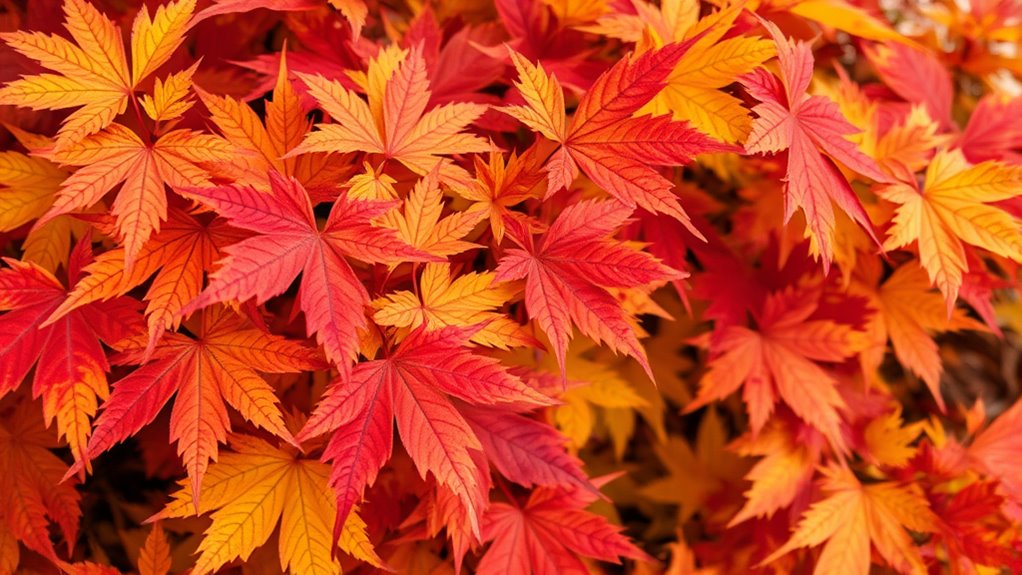
During fall, decorative plants and non-native ornamental foliage add vibrant color to landscapes, but they can also pose hazards if not properly identified or maintained. When planning your garden design and seasonal landscaping, it’s essential to recognize which plants are safe for grazing animals. Some ornamental species contain toxic compounds that can cause illness or even death if ingested. Be cautious of popular ornamental plants like yew, azalea, rhododendron, and certain holly varieties.
- Identify plants before including them in your landscape
- Remove fallen leaves that may be toxic
- Educate yourself on non-native species’ toxicity
- Monitor grazing animals closely around ornamental foliage
Frequently Asked Questions
Which Toxic Leaves Are Most Dangerous to Grazing Animals During Fall?
When considering which toxic leaves are most dangerous to grazing animals during fall, focus on seasonal leaf toxicity and poisonous leaf identification. Leaves like black walnut, oak, and cherry can be highly toxic if ingested. You should be vigilant, especially as leaves change color and fall, because these plants contain compounds that can cause severe health issues. Always monitor grazing areas, identify poisonous leaves early, and prevent animals from consuming hazardous foliage during autumn.
How Can Farmers Identify Toxic Leaves in Mixed Woodland Areas?
Practicing precise plant and leaf identification is paramount for your protection. To spot toxic leaves, look for unusual shapes, colors, or textures, and compare them to trusted guides or images. Focus on plant toxicity recognition by learning key features of dangerous species. Walk woodland areas carefully, noting any unfamiliar foliage. Using field guides or consulting local experts can help you distinguish safe plants from toxic ones, preventing potential harm to your grazing animals.
Are There Any Symptoms Indicating Leaf Poisoning in Livestock?
You should look for symptom recognition in your livestock, as it helps identify poisoning signs early. Common symptoms include drooling, diarrhea, lethargy, and difficulty breathing. If animals show these signs after grazing in mixed woodland areas, it could indicate leaf poisoning. Monitoring their behavior closely allows you to respond quickly and seek veterinary help, preventing further health complications from toxic leaves.
What Precautions Can Prevent Animals From Accessing Toxic Fall Foliage?
Prevent potential poison problems by prioritizing grazing safety during seasonal foliage changes. You should fence off or restrict access to areas with toxic leaves, especially during peak fall when foliage is abundant. Regularly monitor pasture conditions, and consider providing alternative feed to keep animals away from harmful plants. These precautions help protect your livestock from accidental ingestion, ensuring they stay healthy and safe amidst the colorful, but potentially hazardous, fall landscape.
Are Certain Tree Species More Toxic Than Others for Grazing Animals?
Certain tree species are more toxic than others for grazing animals, making tree toxicity an important concern. You should focus on accurate foliage identification to recognize hazardous trees like oak, cherry, or black walnut, which contain toxic compounds. By knowing which trees are more dangerous, you can prevent animals from accessing these species, reducing poisoning risks. Regularly monitoring your landscape and consulting with experts helps guarantee your animals stay safe from toxic foliage.
Conclusion
As beautiful as fall foliage is, don’t let its vibrant colors deceive you. While the scenery invites you to enjoy the season, these toxic leaves pose serious risks to grazing animals. Beauty and danger often go hand in hand, reminding you to stay vigilant. Protect your livestock by recognizing harmful plants amidst the autumn splendor. After all, in the midst of breathtaking color, safety should always be your top priority.



